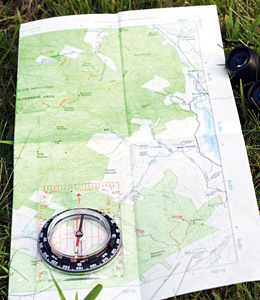I finally gave in to peer pressure recently and sprung for a new iPhone. And, yes, now I see what all the fuss was about. But what I noticed as I was learning how to use my new toy was how hesitant I was to set my own location on the device.
If I could easily find my way around, did that mean others could easily find me, even if I didn't want to be found? I suppose it was a concern about having "Big Brother" watching over me that I found troublesome. Once I stopped thinking about it so much and told my new phone where I was, it immediately became an excellent source of guidance.
We use maps all the time to navigate our territory. But if we don't know where we're starting out, we'll find ourselves lost more often than not. The fact that you can find the corner of Hollywood and Vine on a map won't help you at all if you don't know whether you're starting out a block away from there or from an intersection in downtown San Diego or San Francisco.
Which brings me to the point of this article. To experience sustainable success going forward – especially given the fact that we all now operate in an uncertain and extremely fast-paced world – you must know precisely where you are now, where you stand and what your current reality is.
 Before making plans or setting new goals for your practice, take the time to do a thorough assessment of exactly where you are today, how the recent past brought you to this point, what guideposts you typically use to measure progress and success, and whether those markers continue to be valid based on what you hope to achieve. Only then will you be able to map out a clear route that will get you to your desired location. Here are a few examples of destinations you might be hoping to reach this year.
Before making plans or setting new goals for your practice, take the time to do a thorough assessment of exactly where you are today, how the recent past brought you to this point, what guideposts you typically use to measure progress and success, and whether those markers continue to be valid based on what you hope to achieve. Only then will you be able to map out a clear route that will get you to your desired location. Here are a few examples of destinations you might be hoping to reach this year.
Destination: Financial Strength
If you have financial goals you want to achieve this year, it's not enough to state that you're going to earn or save a certain amount of money, or reduce your debt to a new, lower level. You must first take the time to determine where you are from a financial standpoint at this moment in time. How much have you earned each year for the past several years? What's the trend? How much of what you earned did you spend, save or invest? How much of what you earned seems to have vanished into thin air?
Getting to the bottom of these questions may require spending time with your accountant, financial planner or practice manager. But getting a clear snapshot of what the past few years have looked like and exactly where you are today will help you experience a smoother ride toward your new goals.
Destination: Better Staff
If you have staffing goals for the near future, saying that you want to reduce turnover, do a better job of cross-training or have a staff that is more committed to your practice success is nice, but how you achieve goals such as these requires taking a look at where you stand today and how you got there. Who among your staff is currently trained to do more than one job in the practice? Who has the aptitude to flex their work muscles and learn new skills? What has been the average tenure of your employees over the past three to five years? Do many stay a year or less, or are you typically able to hire and retain good people for years on end? How would you score each of your staff members today in terms of how loyal and committed they are to the practice?
Answering these questions honestly will give you a good assessment of how you've been doing as the leader of the practice and where you stand today relative to the goals you wish to achieve.
Destination: Loyal Patients
If you have patient retention goals for this year, in order to keep your schedule full moving forward with more repeat visits, you'll need to see how you've been doing in this area of late. Understanding patient retention is more difficult than it might seem to be at first glance. How many patients did you see last year only once or twice, even though your recommendation was for a longer-term care plan? When patients leave your practice, do you know their reasons? What is the average length of time the majority of your patients remain under your care, and how do you track this? And what percentage of your patients are referred by friends and family?
Finding the answers to these questions will require some digging, but before you wander off and implement a new plan designed (you hope) to improve patient retention, uncovering the hard facts about where you are now is essential. This area, in particular, is difficult for many chiropractors because it requires them to look at themselves and at how what they do impacts whether patients stay or go, not to mention how patients' needs change over time.
Relying on statistics alone does not take into account the nuances of why patients stay or leave a practice. Try to be as honest with yourself as possible when evaluating this aspect of your practice, and remember that "command and control" is not the answer to improving patient retention.
Start the Journey Toward Sustainable Success
Once you have a clear picture of your current coordinates related to what you wish to achieve and you've stated your desired goal, you're ready to set out on your journey. Be prepared to stop periodically to assess your progress. If you were taking a road trip from Dallas to Chicago, you wouldn't just get in your car, point it in a northeasterly direction and put the pedal to the metal. Instead, you'd periodically reference your map or GPS system to see how far you'd come relative to the length of the trip.
You would build in time to deal with the unexpected, like having a flat tire or spending time in an antique store that attracts your attention, thus making your trip less stressful and more pleasant. You'd stop to refuel and take stretch breaks when needed. And you'd make a note of signage along the way to ensure you hadn't taken a wrong turn that might cause you to end up in Columbus instead of Chicago.
This same principle holds true when you're driving toward sustainable practice success. Ambitiously moving in the direction of your goals is exciting and engaging, but taking the time to monitor your progress along the way, and make adjustments as needed, will serve you well and ensure the positive and enjoyable outcome you're looking for.
Keep in mind that as you drive toward sustainable success, there will be moments that you become uncomfortable with unfamiliar territory. Even if you are following your roadmap carefully, avoiding wrong turns and obvious hazards along the way, detours and roadblocks will appear and conditions will change. When this happens, draw upon your own resilience and your ability to simultaneously stay in the present moment and adjust your plans for moving forward based on the new scenario. Given the uncertainty of practicing today, flexibility and a willingness to make course corrections when needed may be your greatest asset.
I'll wrap this up by asking, very simply: Where are you? If the answer to that question is not immediately clear, then I encourage you to set aside some time in the very near future to get some clarity around your conditions and reality. When we're excited about achieving new goals, the temptation to leap into action is strong, but I can assure you that setting your coordinates before beginning your journey is a worthwhile and essential use of your time.
Click here for previous articles by Shelley Simon, RN, DC, MPH, EdD.





